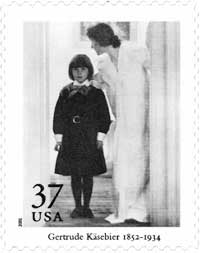I was pleased to see the new US Postage Stamps issue commemorating great American Photographers. I was particularly pleased to see an image by one of my favorite photographers, Gertrude Kasebier.

However, I was particularly displeased when I decided to look up the original image and discovered it was cropped severely. Kasebier would not approve of this alteration. Photographers of this era used to debate endlessly about whether images should ever be cropped.
Kasebier was born in Des Moines, Iowa and traveled to Paris to learn photography and painting. Unfortunately, women artists of this period were relegated to the fringes of the art world. Many people compare her photography to lesser French Impressionists like Marie Cassat, since they both produced many woman-and-child portraits. This is an unfair comparison, Cassat’s work is second rate, while Kasebier’s work was amongst the best of the Photo Secession. Cassat had little influence on her peers, while Kasebier was extremely influential.
Kasebier is particularly important to me because she worked in media like Platinography and Gum Bichromate. Of course in those days, these were the standard methods for producing fine art photography. Today, these methods are mostly a lost art and are considered an “alternate process.” I work with these same processes, precisely because I see the same pictorial advantages of those processes that Kasebier saw.
I remember seeing an original Kasebier print at the huge “150 years of Photography” exhibit at the LA County Museum of Art. These prints are so rich that no reproduction could possibly capture them. Since then, I have sought to produce photographs that must be seen firsthand. I owe much to Kasebier’s work, so it irritates me to see her work altered so severely at the same time it finds a wider audience than it ever has.
I completely agree with you except for one thing – it is a stamp, which is… very tiny. They probably wanted to give us a smidgen of an eye break.